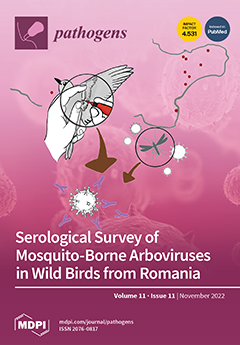In the present study, we investigated the isolation frequency, the genetic diversity, and the infectious characteristics of
Staphylococcus aureus and methicillin-resistant
S. aureus (MRSA) from the incoming meat and the meat products, the environment, and the workers’ nasal cavities, in two meat-processing establishments
[...] Read more.
In the present study, we investigated the isolation frequency, the genetic diversity, and the infectious characteristics of
Staphylococcus aureus and methicillin-resistant
S. aureus (MRSA) from the incoming meat and the meat products, the environment, and the workers’ nasal cavities, in two meat-processing establishments in northern Greece. The isolated
S. aureus strains were examined for their resistance to antimicrobials, carriage of the
mecA and
mecC genes, carriage of genes encoding for the production of nine staphylococcal enterotoxins, carriage of the Panton–Valentine Leukocidin and Toxic Shock Syndrome genes, and the ability to form biofilm. The genetic diversity of the isolates was evaluated using Pulsed Field Gel Electrophoresis (PFGE) and
spa typing.
S. aureus was isolated from 13.8% of the 160 samples examined, while only one sample (0.6%) was contaminated by MRSA carrying the
mecA gene. The evaluation of the antimicrobial susceptibility of the isolates revealed low antimicrobial resistance. The higher resistance frequencies were observed for penicillin (68.2%), amoxicillin/clavulanic acid (36.4%) and tetracycline (18.2%), while 31.8% of the isolates were sensitive to all antimicrobials examined. Multidrug resistance was observed in two isolates. None of the isolates carried the
mecC or
lukF-PV genes, and two isolates (9.1%) harbored the
tst gene. Eight isolates (36.4%) carried the
seb gene, one carried the
sed gene, two (9.1%) carried both the
sed and
sei genes, and one isolate (4.5%) carried the
seb, sed and
sei genes. Twenty-one (95.5%) of the isolates showed moderate biofilm production ability, while only one (4.5%) was characterized as a strong biofilm producer. Genotyping of the isolates by PFGE indicates that
S. aureus from different meat-processing establishments represent separate genetic populations. Ten different
spa types were identified, while no common
spa type isolates were detected within the two plants. Overall, our findings emphasize the need for the strict application of good hygienic practices at the plant level to control the spread of
S. aureus and MRSA to the community through the end products.
Full article






